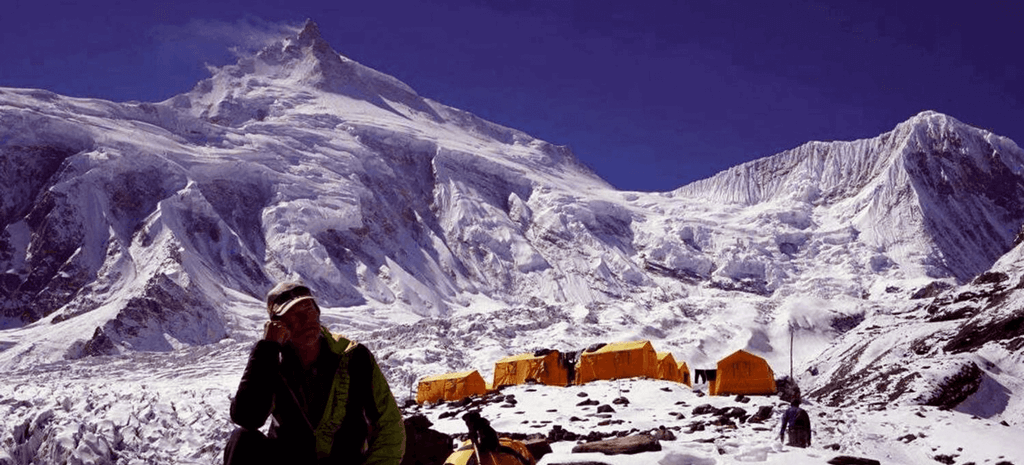17th June, 2025

Oct 03, 2023
Manaslu Circuit Trek in January
- Successful Manaslu Circuit Trek in January Tips
- Is Manaslu Circuit Trek Teahouse Open in January?
- Why Manaslu Circuit Trek in January: Is It Good to Trek to Manaslu in January?
- Can I Do Manaslu Circuit Trek Solo?
- Transportation Mode on Manaslu Trek
- Guide and Porter
- Food and Accommodation
- Manaslu Circuit Trek Required Permit
- How Hard is Manaslu Circuit Trek In January
- Manaslu Circuit Trek In January Weather, Climate and Temperature
- Conclusion
- Manaslu Region Trek Packages
The Manaslu Circuit Trek in January offers a thrilling and serene adventure for those seeking to explore the majestic Himalayas during the winter season. Located in the Gorkha District of Nepal, the Manaslu Circuit is known for its stunning landscapes, diverse flora and fauna, and rich cultural experiences. January, with its crisp, cold air and clear skies, provides trekkers with unobstructed views of the snow-covered peaks, including the awe-inspiring Mount Manaslu, the eighth highest mountain in the world.
One of the most appealing aspects of trekking in January is the tranquility and solitude. The trails are significantly less crowded compared to the peak trekking seasons, allowing for a more personal and immersive experience. The local villages, such as Namrung, Lho, and Samagaun, offer a warm welcome and a glimpse into the traditional Tibetan-Buddhist culture, with their ancient monasteries and unique customs.

MANASLU CIRCUIT TREK
Manaslu Circuit Trek is one of Nepal’s most spectacular and less-explored trekking routes, perfect for adventurers seeking a blend of stunning mountain views, rich Tibetan culture, and off-the-beaten-...
However, trekking in January also presents certain challenges. The temperatures can be extremely cold, especially at higher altitudes, necessitating proper gear and clothing to ensure safety and comfort. The Larkya La Pass, standing at 5,160 meters, can be particularly demanding due to snow and icy conditions, requiring trekkers to be well-prepared and physically fit.
Despite these challenges, the rewards of the Manaslu Circuit Trek in January are immense. The pristine beauty of the winter landscape, the sense of achievement upon completing the trek, and the opportunity to experience the untouched beauty of the Himalayas make this trek an unforgettable adventure. For those who are well-prepared and eager for a winter trekking experience, the Manaslu Circuit in January promises a journey of a lifetime.
Successful Manaslu Circuit Trek in January Tips
Trekking the Manaslu Circuit in January presents unique challenges and rewards for adventurers prepared for colder temperatures and potentially snowy conditions. Here are essential tips for a successful trek:
Cold-Weather Gear: January in the Himalayas means freezing temperatures, especially at higher altitudes. Pack thermal layers, insulated clothing, a good quality down jacket, waterproof outer layers, gloves, hats, and warm socks. Ensure your gear is adequate for sub-zero temperatures.
Proper Acclimatization: Take the time to acclimatize properly to avoid altitude sickness. Plan rest days at strategic points along the route and ascend gradually. Listen to your body and watch for symptoms like headaches, nausea, or dizziness.

TSUM VALLEY TREK
Tsum Valley Trek is one of the most fascinating and culturally rich treks in Nepal. It is located in the northern part of the Gorkha district, close to the Tibetan border. The Tsum Valley is a sacred...
Stay Hydrated and Nourished: Drink plenty of water, even though it's cold. Dehydration can exacerbate altitude sickness. Carry a water purification system to ensure access to safe drinking water throughout the trek. Eat regular, carbohydrate-rich meals to maintain energy levels.
Check Weather Forecasts: Stay informed about weather conditions before and during your trek. January can bring snowfall, affecting trail conditions and visibility. Be prepared to adjust your itinerary or take rest days if weather conditions become severe.
Safety Precautions: Always prioritize safety. Trek with a licensed guide who knows the area well. Stick to marked trails and avoid risky shortcuts, especially in snowy or icy conditions. Carry a basic first aid kit and know how to use it.
Early Starts: Days are shorter in January, so start trekking early to make the most of daylight hours. Plan your trekking schedule accordingly and have a headlamp or flashlight for early morning starts or late afternoon hikes.
Enjoy the Quiet: January sees fewer trekkers on the trail compared to peak seasons. Enjoy the solitude and serene beauty of the Manaslu region without the crowds.
Respect Local Culture: Embrace the local customs and traditions of the communities you encounter along the way. Respect their way of life and show gratitude for their hospitality.

MANASLU TSUM VALLEY TREK - 23 DAYS
This epic adventure explores the iconic Mt. Manaslu region and the immense Tsum Valley (Hidden Valley).This trek circumnavigates Mt. Manaslu (8th highest mountain in the world at 8156m) and thro...
Trekking the Manaslu Circuit in January offers a quieter and more challenging adventure amidst stunning winter landscapes. With proper preparation and a spirit of adventure, January can be an ideal time to experience the natural beauty and cultural richness of this remote Himalayan region.
Is Manaslu Circuit Trek Teahouse Open in January?
The Manaslu Circuit trek, renowned for its stunning views and remote wilderness, typically experiences fewer trekkers during January due to colder temperatures and the potential for snow. While the trek is indeed open year-round, some teahouses along the route may be closed or have limited services in the winter months.
In particular, the teahouses in Samdo and Dharmasala (or Larke Phedi) are known to be less reliable during January. Due to the harsh weather conditions and lower number of trekkers, some of these lodges might be closed, leaving you without the usual amenities like food and shelter. As a result, it is highly advisable to be prepared for this possibility.
To ensure a safe and comfortable trek, it is best to bring your own tent and cooking equipment. This way, you can camp at designated spots and cook your own meals if necessary. By planning ahead and preparing for potential teahouse closures, you’ll be better equipped to handle the challenges of trekking Manaslu Circuit in January.

12 Days Manaslu Circuit Trek
The Manaslu Circuit Trek 12 Days is a truly immersive Himalayan journey that takes you deep into the Manaslu Conservation Area, offering solitude, breathtaking scenery, and rich cultural encounters. C...
Why Manaslu Circuit Trek in January: Is It Good to Trek to Manaslu in January?
Trekking the Manaslu Circuit in January offers a unique adventure for those seeking solitude and pristine landscapes. January, part of the winter season in Nepal, means fewer trekkers on the trail, which allows for a more peaceful and solitary experience compared to the peak trekking seasons. The snow-covered landscapes and clear skies can make for breathtaking scenery, offering stunning views of the snow-capped peaks of the Himalayas, including Mount Manaslu.
However, trekking in January comes with its challenges. The temperatures can drop significantly, especially at higher altitudes, making it quite cold and potentially uncomfortable. Snowfall can also block trails or make trekking conditions more difficult. Additionally, some teahouses along the Manaslu Circuit, particularly in remote areas like Samdo and Dharmasala, may be closed due to the low number of trekkers and harsh weather conditions.
Despite these challenges, if you are well-prepared with proper winter gear, a good sleeping bag, and a tent for camping, trekking in January can be a rewarding experience. The serene environment and fewer crowds offer a rare opportunity to experience the natural beauty of the Manaslu region in its winter glory.
Why Manaslu Trek is Famous
The Manaslu Trek is renowned for its breathtaking beauty, cultural richness, and the opportunity to explore an off-the-beaten-path region of Nepal. Named after Mount Manaslu, the eighth highest peak in the world, this trek offers stunning panoramic views of the Himalayas, lush valleys, and diverse landscapes. The trek also traverses through the Manaslu Conservation Area, known for its rich biodiversity, including rare wildlife like the snow leopard and red panda. Additionally, the trek provides an authentic cultural experience, passing through traditional Tibetan-influenced villages and ancient monasteries. The Manaslu Circuit is less crowded compared to other popular treks like the Annapurna or Everest circuits, making it an ideal choice for trekkers seeking tranquility and a deeper connection with nature and local culture.

Manaslu Circuit Trek 14 Days
Experience the Manaslu Circuit Trek 14 Days, a high-altitude Himalayan odyssey that stands among Nepal’s most enthralling off-the-beaten-path adventures. This immersive trek circles Mount Manaslu (8,1...
Can I Do Manaslu Circuit Trek Solo?
Trekking the Manaslu Circuit solo is not recommended. The trek is located in a remote and relatively challenging area, and the Nepalese government requires all trekkers to be accompanied by a licensed guide or join a group trek for safety reasons. Solo trekking is not permitted due to the potential risks involved, such as the challenging terrain, unpredictable weather, and the necessity for permits. Having a guide or joining a group trek ensures that you have local knowledge, support in case of emergencies, and assistance with navigating the complex trail. It also helps in obtaining the necessary permits and adhering to local regulations. While the experience of trekking with a guide or in a group may differ from solo trekking, it significantly enhances safety and overall enjoyment of the journey.
Transportation Mode on Manaslu Trek
Transportation to the Manaslu Trek starts with a drive from Kathmandu to Soti Khola, the starting point of the trek. This journey typically involves a long but scenic drive of around 6-8 hours through winding roads and rural landscapes. The most common mode of transport is a private or public jeep, which offers a more comfortable and faster alternative compared to local buses. The road conditions can vary, so it is advisable to travel in a well-maintained vehicle. Once you reach Soti Khola, the trek itself is completed on foot, navigating through a variety of terrains including lush forests, terraced fields, and high mountain passes. During the trek, local transportation is generally not required, as the journey is completed by trekking from one village to the next.

Manaslu Circuit Trek 10 Days
The Manaslu Circuit Trek 10 Days is one of the most spectacular high-altitude trekking adventures in Nepal, offering a remote Himalayan experience away from the commercial crowds of the Annapurna and...
Guide and Porter
Hiring a guide and porter for the Manaslu Circuit Trek is highly recommended and often required. A licensed guide not only helps with navigation but also provides valuable insights into local culture, history, and ensures compliance with local regulations and safety protocols. They can also assist in communicating with locals, managing permits, and dealing with unforeseen issues. A porter, on the other hand, carries your heavy luggage, allowing you to trek more comfortably and focus on enjoying the scenery. While it is possible to trek with a guide alone, having both a guide and porter enhances the overall trekking experience by providing support, local knowledge, and reducing physical strain. Their services ensure a safer and more enjoyable trek through the rugged and remote terrain of the Manaslu Circuit.
Food and Accommodation
On the Manaslu Circuit Trek, food and accommodation are typically provided in teahouses, which are small, family-run lodges found along the route. The accommodation ranges from basic rooms with shared facilities to more comfortable options depending on the location and availability. Most teahouses offer simple, clean rooms with basic bedding and hot showers where possible.
For food, teahouses usually serve traditional Nepali dishes such as dal bhat (lentil soup with rice), momos (dumplings), and noodle soups. Some places might also offer Western dishes like pasta or fried rice. While the variety of food may be limited compared to urban areas, the meals are generally nutritious and designed to sustain trekkers. It is important to carry some snacks for high-altitude days when teahouses might be sparse. As you progress on the trek, food options become more limited, so it’s advisable to have a flexible attitude and be prepared for basic meals.

Manaslu Circuit Trek 9 Days
The Manaslu Circuit Trek 9 Days journeys through Nepal’s untouched high country for those seeking an off-the-beaten-path trek. Celebrate the solitude of the Manaslu Conservation Area as the trail enci...
Manaslu Circuit Trek Required Permit
To trek the Manaslu Circuit, obtaining the necessary permits is crucial. In January, as with other months, trekkers must secure the Manaslu Restricted Area Permit (RAP) and the Manaslu Conservation Area Permit (MCAP). These permits are mandatory to enter the restricted region and contribute to conservation efforts. Permits can be obtained through registered trekking agencies in Kathmandu or at the Nepal Tourism Board. Additionally, trekkers must be accompanied by a licensed guide throughout the trek, ensuring compliance with regulations and enhancing safety. These measures help preserve the natural and cultural integrity of the Manaslu region while supporting sustainable tourism practices.
How Hard is Manaslu Circuit Trek In January
Trekking the Manaslu Circuit in January presents increased challenges due to harsh winter conditions. The trek involves navigating through snow-covered trails, especially at higher elevations and during passages like the Larkya La Pass (5,160 meters). Snow and ice can make sections of the trail slippery and more physically demanding. Short daylight hours require early starts and efficient trekking to maximize daylight. The cold temperatures, with daytime highs ranging from 0 to 10°C (32 to 50°F) and nighttime lows dropping well below freezing, necessitate proper cold-weather gear including insulated clothing, waterproof layers, and sturdy footwear with crampons or spikes.
Despite the challenges, January offers a quieter trekking experience with fewer crowds and stunning winter vistas. Proper physical preparation, acclimatization, and adherence to safety protocols are essential for a successful trek in January.

MANASLU CIRCUIT TREK 8 DAYS
The Manaslu Circuit Trek 8 Days is a remote Himalayan adventure that delivers a perfect blend of natural beauty, cultural richness, and high-altitude challenge. This trek offers a less-traveled, immer...
Manaslu Circuit Trek In January Weather, Climate and Temperature
January weather on the Manaslu Circuit is characterized by cold temperatures and the possibility of snowfall. Daytime temperatures at lower elevations can range from 0 to 10°C (32 to 50°F), while temperatures drop significantly at higher altitudes, often reaching below freezing. Nights are extremely cold, with temperatures plummeting well into the negative digits, especially at higher camps and passes like Larkya La (5,160 meters).
Snowfall is common in January, transforming the landscape into a winter wonderland but also presenting challenges such as slippery trails and reduced visibility. Clear, sunny days are less frequent, and trekkers should be prepared for overcast skies and occasional snowstorms, which can affect trail conditions and trekking schedules.
Proper preparation with cold-weather clothing, waterproof gear, and suitable footwear is essential for comfort and safety. Trekking routes may be quieter in January, offering a serene and peaceful environment amidst the snow-capped peaks and pristine landscapes of the Manaslu region.

MANASLU CIRCUIT TREK 7 DAYS
The 7 Days Manaslu Circuit Trek offers a thrilling, high-altitude Himalayan journey for trekkers looking to experience the raw, untouched beauty of Nepal's remote mountain trails. This short yet power...
Conclusion
Trekking the Manaslu Circuit in January offers a challenging yet rewarding adventure amidst the stunning winter landscapes of the Himalayas. Despite the cold temperatures and potential snowfall, January provides a quieter trekking experience with fewer crowds, allowing for a more intimate connection with nature and local communities. The trek's highlights include crossing the iconic Larkya La Pass and exploring diverse landscapes ranging from lush forests to high-altitude plateaus.
However, trekkers must be well-prepared with cold-weather gear, proper acclimatization, and adherence to trekking regulations, including obtaining the necessary permits and trekking with a licensed guide. The weather in January can be unpredictable, necessitating flexibility and caution on the trail.
Ultimately, trekking the Manaslu Circuit in January offers an unforgettable journey for adventurers seeking a unique blend of natural beauty, cultural immersion, and Himalayan challenge. With proper planning and preparation, January proves to be an ideal time to embark on this remarkable trekking experience.
Manaslu Region Trek Packages

MANASLU CIRCUIT TREK 6 DAYS
Manaslu Circuit Trek 6 Days is an exhilarating and compact trekking adventure designed for those eager to explore the majestic Manaslu region within a limited timeframe. The journey begins with an 8-9...
Any Questions? Let Us Know.
Recent Posts
14th June, 2025
12th June, 2025




















